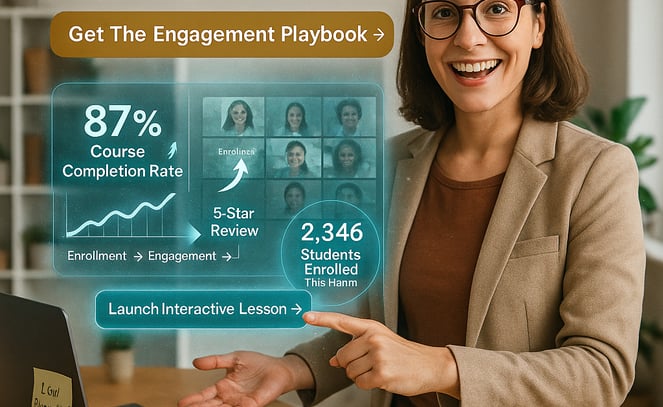How to Create an Engaging Online Learning Platform That Converts
Discover the essential steps to build an engaging online learning platform that attracts students, keeps them motivated, and drives conversions.
ONLINE LEARNING PLATFORMS
6/5/20253 min read


Introduction
The online education industry is booming, with millions of learners turning to digital platforms to acquire new skills and knowledge. However, with so many options available, creating an online learning platform that stands out and converts visitors into paying students is no easy task.
An engaging platform isn’t just about delivering content—it’s about creating an immersive, interactive, and personalized learning experience that keeps students motivated and coming back for more. In this article, we’ll walk you through the essential steps to build an online learning platform that converts.
Step 1: Define Your Niche and Target Audience
What It Is: Identifying the specific subject area and audience your platform will serve.
Why It Matters: A clear niche helps you stand out in a crowded market and tailor your content to meet the needs of your target audience.
How to Implement:
Research market trends and identify gaps in the online education space.
Create detailed learner personas to understand your audience’s goals, challenges, and preferences.
Focus on a niche that aligns with your expertise and has high demand.
Pro Tip: Use tools like Google Trends or Ahrefs to analyze search interest in your niche.
Step 2: Design a User-Friendly Interface
What It Is: Creating an intuitive and visually appealing platform that’s easy to navigate.
Why It Matters: A cluttered or confusing interface frustrates users and increases bounce rates.
How to Implement:
Use a clean, modern design with consistent branding.
Organize content into clear categories and modules.
Ensure the platform is mobile-friendly and responsive.
Pro Tip: Test your platform’s usability with tools like UsabilityHub or Hotjar.
Step 3: Develop High-Quality Content
What It Is: Creating engaging, informative, and actionable course materials.
Why It Matters: High-quality content is the backbone of any successful learning platform.
How to Implement:
Use a mix of formats like videos, quizzes, PDFs, and interactive exercises.
Break content into bite-sized modules for easier consumption.
Include real-world examples and case studies to make lessons practical.
Pro Tip: Invest in professional video production and editing tools to enhance the quality of your content.
Step 4: Incorporate Interactive Elements
What It Is: Adding features that encourage active participation and engagement.
Why It Matters: Interactive elements keep learners motivated and improve knowledge retention.
How to Implement:
Include quizzes, polls, and assignments to test understanding.
Use gamification techniques like badges, leaderboards, and rewards.
Enable discussion forums or live Q&A sessions for community interaction.
Pro Tip: Use platforms like Thinkific or Teachable that offer built-in interactive features.
Step 5: Personalize the Learning Experience
What It Is: Tailoring content and recommendations based on individual learner needs.
Why It Matters: Personalization increases engagement and makes learners feel valued.
How to Implement:
Use AI-driven tools to recommend courses based on learner behavior.
Offer customizable learning paths or progress tracking.
Send personalized emails with course updates and tips.
Pro Tip: Use learning management systems (LMS) like Moodle or Canvas that support personalization.
Step 6: Optimize for Conversions
What It Is: Designing your platform to encourage visitors to sign up and purchase courses.
Why It Matters: A well-optimized platform maximizes revenue and growth.
How to Implement:
Use clear, compelling CTAs like “Start Learning Now” or “Enroll Today.”
Offer free trials or sample lessons to reduce hesitation.
Display testimonials, reviews, and success stories to build trust.
Pro Tip: Use A/B testing to optimize landing pages and CTAs for higher conversions.
Step 7: Provide Excellent Support
What It Is: Offering resources and assistance to help learners succeed.
Why It Matters: Good support builds trust and encourages repeat business.
How to Implement:
Provide FAQs, tutorials, and troubleshooting guides.
Offer live chat or email support for quick problem resolution.
Create a community forum where learners can help each other.
Pro Tip: Use chatbots to provide instant support and reduce response times.
Real-World Example: How an Engaging Platform Boosted Conversions
Let’s look at a real-world example of how an online learning platform increased conversions:
The Problem:
A coding bootcamp platform had low enrollment rates despite offering high-quality courses.
The Solution:
They redesigned their platform with a user-friendly interface, added interactive coding exercises, and introduced personalized learning paths.
The Results:
The platform saw a 40% increase in enrollments and a significant improvement in learner retention.
Conclusion
Creating an engaging online learning platform that converts requires a combination of high-quality content, user-friendly design, and personalized experiences. By following these steps, you can attract more students, keep them motivated, and drive long-term success for your platform.
Start building your platform today, and unlock the potential of online education!
